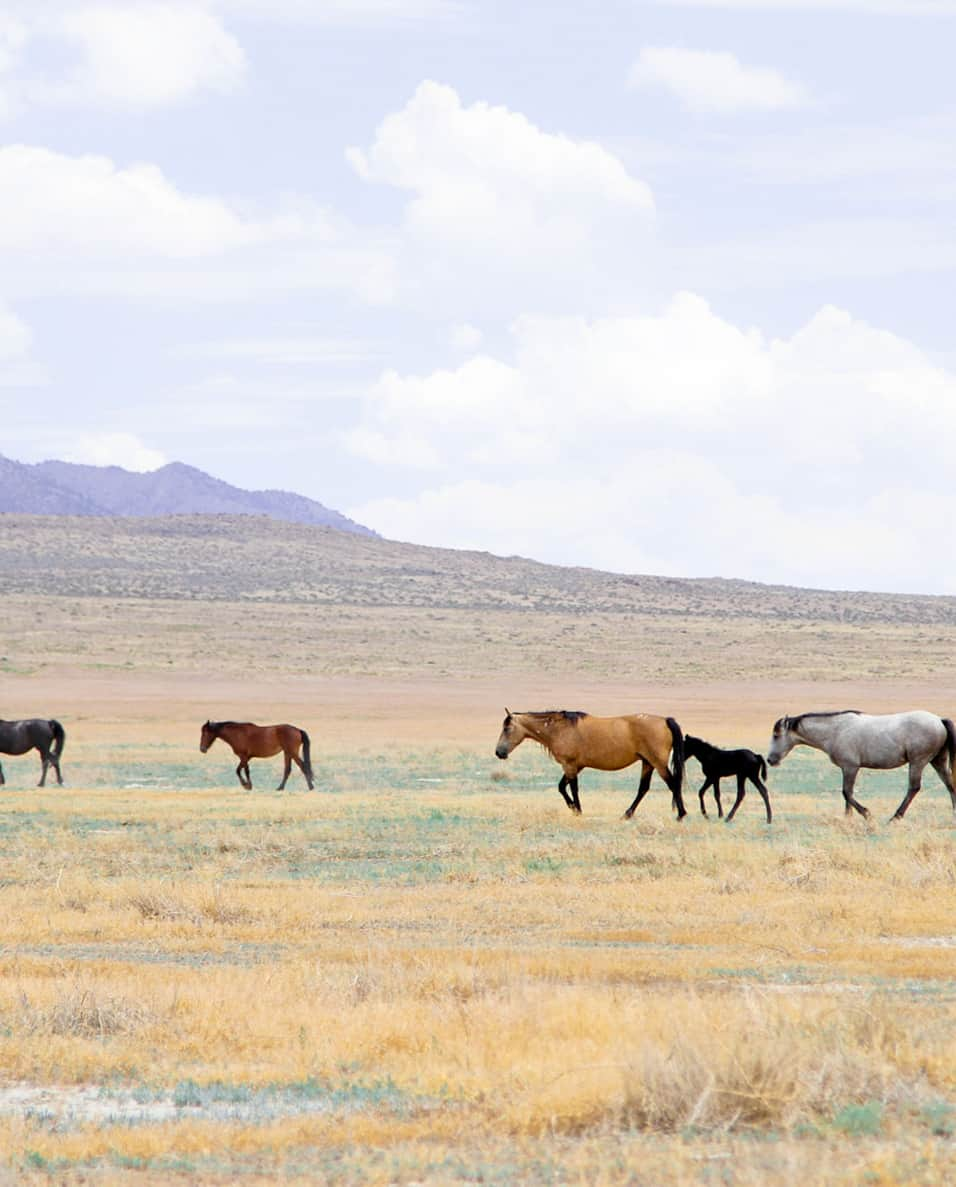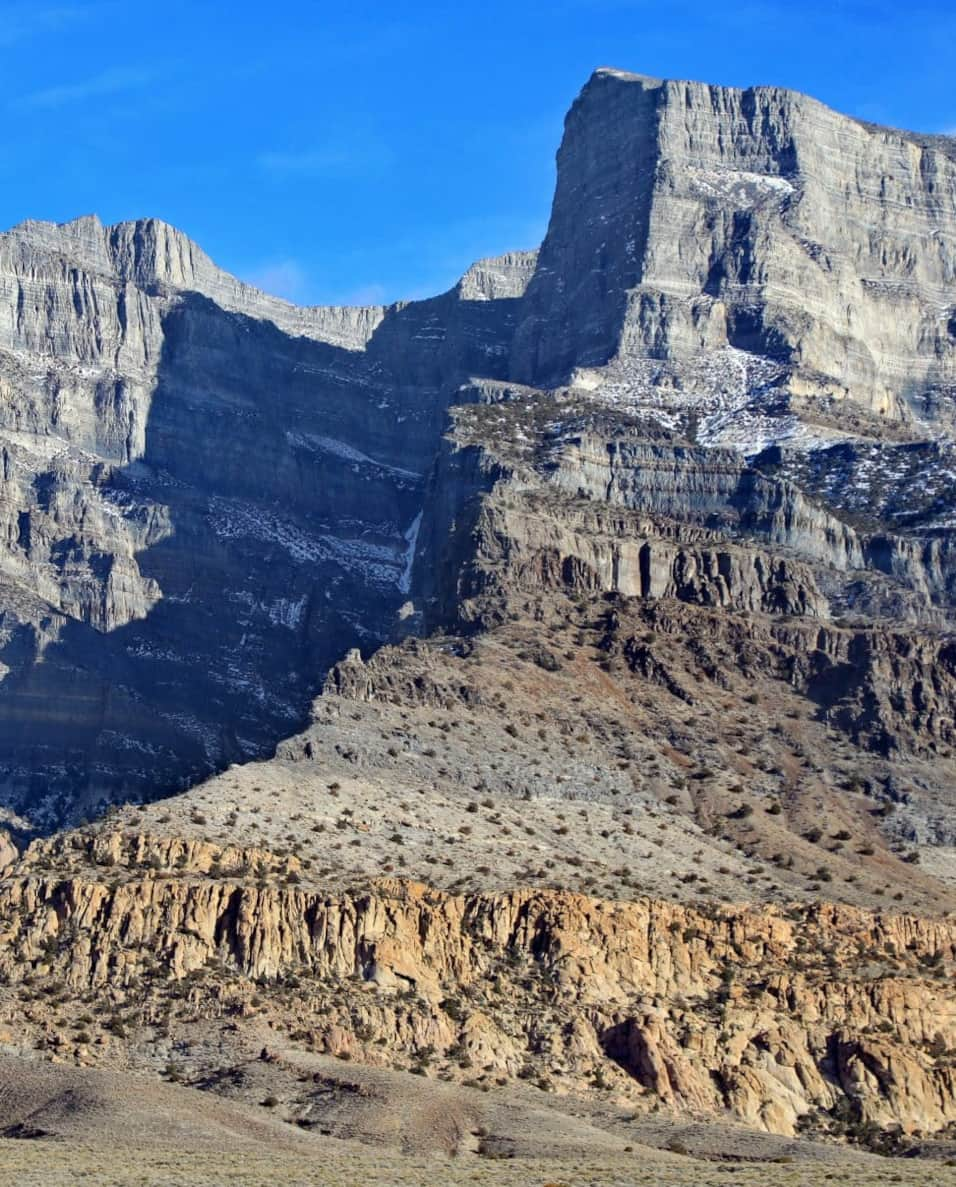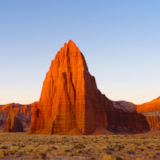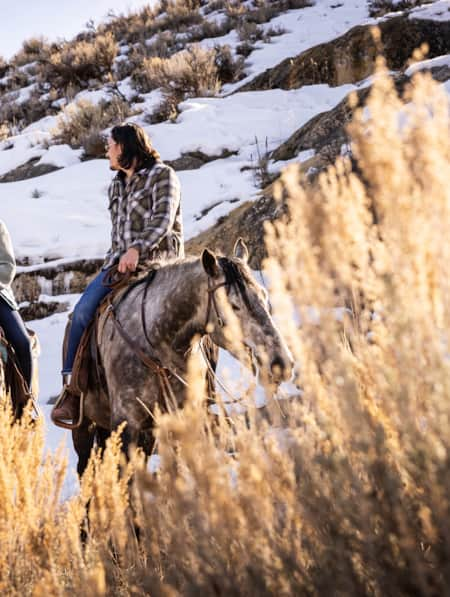The Herds of the West Desert
Searching for wild mustangs amongst Utah’s rolling hills

In the mountain ranges and valleys surrounding the Great Basin National Heritage Area, hooves strike the sagebrush-speckled desert floor between the rippling mountains of the Confusion and House ranges. Stocky legs push off the ground with each gallop. The momentum is palpable, and the power resonates with each strike of the earth.
In this remote area, ridgelines spread like winding rivers and tributaries, running north and south along fault lines, rising out of vast flatlands. The mountainous layers in the distance change color as light dances across them. Out in the hills, clouds roll over the plateaued peaks, dusting light rain across the mountaintops.
But in the valley, sunlight blasts the parched ground, as tufts of ricegrass sway in the hot breeze. Devoid of human residents, this is the land of wild horses: groups of mustang herds that live in the basins and foothills of Central Utah.
Herd Management Areas
There are 19 Herd Management Areas on nearly 2.5-million acres of public rangelands across Utah. They are heavily managed by the Bureau of Land Management to achieve healthy populations that live in harmony with the fragile desert environment. The mustangs in these herds, like many wild horses, are descendants of domesticated horses that escaped from Western ranches. (Read: “5 Best Ways to View Wild Horses in Utah”.)
Two herd management areas — the Conger and Swasey — inhabit the foothills and basins of Central Utah. Road networks of old highways and dusty ATV trails link these two herds and create a unique wild horse viewing experience for those willing to put in some work.


Recommended Road Trip
In Millard County, In Millard County, home to the Great Basin National Heritage Area, the chances of spotting these herds are relatively high from a variety of roads, from paved highways to 4WD roads. One of the most popular routes for catching a glimpse of these horses is a loop through the Conger and Swasey areas.
This day trip starts in Delta and requires at least five to six hours of driving time there and back. If you want to make this a two-day trip, dispersed camping is permitted on Bureau of Land Management land here. By spending the night in this exquisite region, you can slow down and observe your surroundings. The more time spent in these areas, the higher the chance of sighting wild horses. (Itinerary: Grand Adventure in the Great Basin)
First Stop: Swasey Herd Management Area
On the east side of Swasey Peak there’s a very accessible herd — mustangs are often spotted from any main road in the area. From Delta, head west for 12.5 miles until the unsigned Old 6 & 50 is on your right. This road is easy to miss, so prepare with maps or a GPS. Once you turn, the Swasey Herd Management Area will be on your right. Follow this road for just about 28 miles until you reach an intersection with Death Canyon Road. Turn right towards Antelope Spring and U-Dig Fossils.
These undulating roads will take you up and over knolls and through canyons in the foothills under Swasey Peak. Drive slowly and keep an eye out for mustangs along this stretch. Small ponds form in the depressions between highlands, and horses frequent these water sources. If you come across a watering hole, turn off your car and speak quietly. These oases are a vital part of the ecosystem: Desert species rely on this sparse water for survival, so minimize your impact by treading lightly and packing out everything you brought in with you.
Once you’ve sufficiently explored the backroads in the Swasey foothills, head back south to Old 6 & 50. Continue west across Marjum Pass and through Marjum Canyon, where the narrow canyon walls create shade and allow plant life to flourish. You’ll pass Hermit’s Cabin, a natural cave bordered by slices of rock and old logs. Soot-covered rocks guard the entrance. This historical site is a short walk from the road and is well worth a visit.
Second Stop: Conger Herd Management Area
As you approach the Conger area, big skies open to sights of the Conger Mountains in the distance and sandy roads weave through juniper-dotted hills. If you catch sight of the herd along the south side of the road, you can watch as the mustangs send up plumes of dust when their hooves pound into the earth, reverberating through the dry land. Wild horses can be incredibly powerful, so always maintain a safe viewing distance and never attempt to approach the herd.
Continue along Old 6 & 50 for 13 more miles until you reach the Skunk Spring 3 sign. If you want the best chance of sighting the Conger herd, turn left towards Skunk Spring and Conger Spring. These locations are frequented by mustangs, so spending time on these dirt roads will give you the best chance of a sighting. However, these roads splay out in labyrinth-like webs, so Millard County ATV trail maps will be helpful if you intend to take this detour.
Once you’ve had your fill, return the way you came. Or continue weaving south on dirt roads until you reach US-50, where you can cruise on pavement back to Delta.
It may take a little effort to spot these wild horses. But it’s well worth the time spent chasing when you catch a glimpse of cream-colored stallions with billowing blonde tails that match the yellowing grass, or chestnut brown and black horses that dash across the valley with ease.

Utah is home to 22 herds of wild horses that graze in desert plains and congregate at watering holes.
Photo: Greig Huggins

These herds came into existence in the 1800s when domestic horses escaped from local ranchers and settled into lives of freedom. These mustangs soon came to be considered an indispensable part of Utah’s public lands.
Photo: Rosie Gochnour Serago

n 1971, Congress passed the Wild Free-Roaming Horses & Burros Act to protect these horses as “living symbols of the historic and pioneer spirit of the West.” Today, these wild horses live in herd management areas (HMAs) around the state.
Photo: Rosie Gochnour Serago

5 Best Ways to View Wild Horses in Utah
There are plenty of opportunities for viewing wild horses in Utah. Here are five things you need to do and plan on to increase the likelihood you will spot these majestic creatures and get the most of your adventure.
What's Nearby
-
Delta
Delta is known as a base camp for exploring the Little Sahara Sand Dunes and the West Desert. Delta is a stopping point on the way to Great Basin National Park, visiting town to see the Great Basin and Topaz Museums, Fort Deseret and the old Van’s Dance Hall.
-
Eureka Ghost Town
On state Route 6 from Salt Lake City to Delta, you’ll find the mining ghost town of Eureka. Founded in 1870 when gold and silver were discovered there, the population boomed in 1910 to nearly 4,000 inhabitants. Today, 600 folks still call Eureka home, and its historic buildings are on the National Register of Historic Places. Explore its mining heyday at the old jail and the Tintic Mining Museum.
-
Fort Deseret
Head over to the neighboring town of Deseret and see Utah’s last remaining adobe fort. Built in 1865 to protect settlers during the Black Hawk Indian War, the adobe mud and straw mixture used in Fort Deseret’s construction was “mixed by the feet of oxen,” and built in just 18 days by 98 men.
-
Great Basin National Park
Delta is the gateway to Nevada’s Great Basin National Park, one of the country’s least-visited national parks due to its remote location. But that doesn’t mean you shouldn’t visit! Great Basin is home to 13,063-foot Wheeler Peak (the state’s second highest mountain), Lehman Caves and ancient bristlecone pine trees. Guided cave tours showcase Lehman’s limestone stalagmites, stalactites and rarer formations. See the world’s oldest known living trees on bristlecone pine trails to Wheeler Peak, Eagle Peak and Mount Washington.
-
Little Sahara Sand Dunes
Explore the remnants of an ancient river delta at 60,000-acre Little Sahara Recreation Area, 38 miles from Delta. Off-highway-vehicle riding is the most popular pursuit for exploring the region’s sand dunes and trails, and it’s especially popular to climb Sand Mountain — a 700-foot wall of sand. Venture off from here and you’ll likely be all alone in this huge expanse of the Sevier Desert.
-
Yuba Lake State Park
Sandy beaches, warm water, and excellent fishing draw visitors to Yuba Lake State Park, just one hour east of Delta. Yuba Reservoir welcomes every type of water recreationist, and there’s even boat-camping along its shores.







